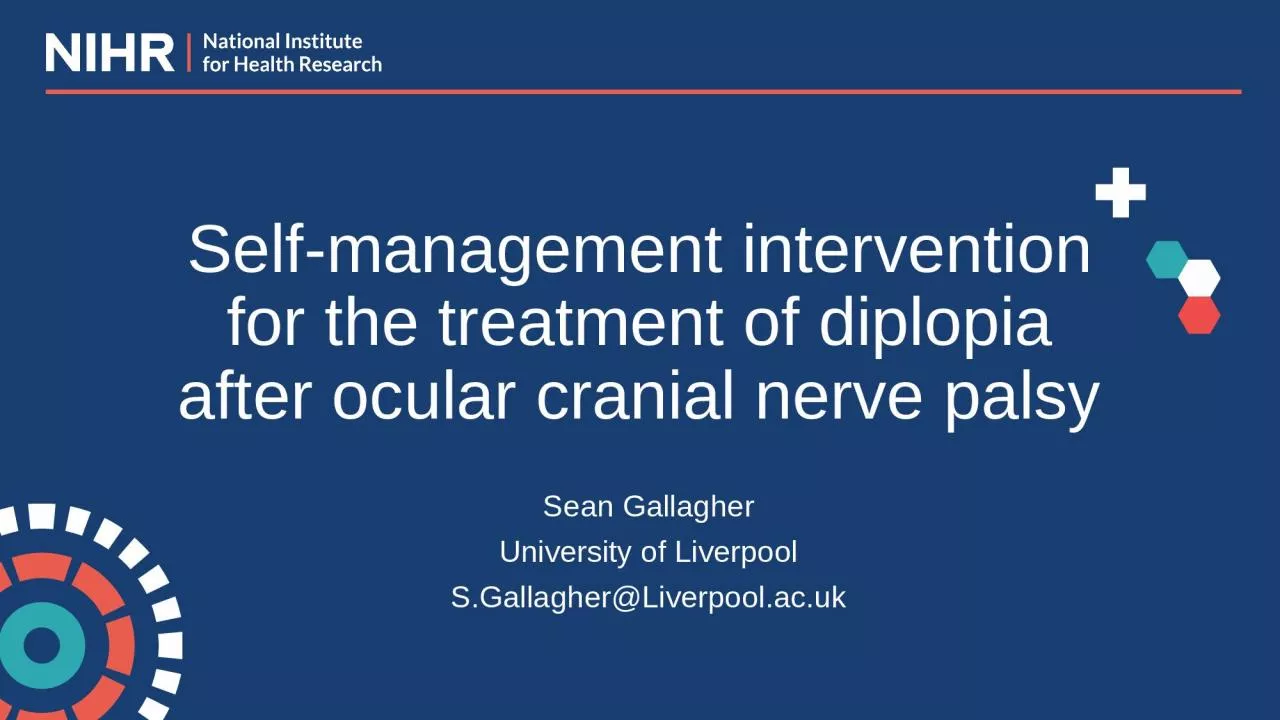

Sean Gallagher University of Liverpool SGallagherLiverpoolacuk Brief Overview How the work aligns to and supports the NIHR ARC NWC and Person Centred Complex Care priorities Most common cause of OCNP is after a microvascular or cerebrovascular event the NWC has one of the highest rates of ID: 931890
Download Presentation The PPT/PDF document "Self-management intervention for the tre..." is the property of its rightful owner. Permission is granted to download and print the materials on this web site for personal, non-commercial use only, and to display it on your personal computer provided you do not modify the materials and that you retain all copyright notices contained in the materials. By downloading content from our website, you accept the terms of this agreement.
Slide1
Self-management intervention for the treatment of diplopia after ocular cranial nerve palsy
Sean Gallagher
University of Liverpool
S.Gallagher@Liverpool.ac.uk
Slide2Brief Overview
Slide3How the work aligns to and supports the NIHR ARC NWC and Person Centred Complex Care priorities
Most common cause of OCNP is after a microvascular or cerebrovascular event; the NWC has one of the highest rates of stroke in the country, therefore, one can infer that OCNPs may happen at a higher rate in the NWC than elsewhere.
Through faster recovery of diplopia, the patient can focus on recovering from other potential co-morbidities.
The treatment will not require the patient to invest in anything and has been designed to be performed by the patient themselves or with the help of one other person. There is no equipment necessary. This treatment can therefore be accessed by everyone regardless of socioeconomic status.
If the treatment shows increased recovery rate, then we can save both patients and the NHS money
Slide4How the research has been, and continues to be, informed by the HIAT
Development of the project was made with the HIAT in mind due to the health inequalities present surrounding OCNP:
Most likely caused is after a vascular event
Those of lower socioeconomic status are more likely to suffer from them
Treatment of diplopia often requires multiple visits and access to glasses/patches at the patient’s expense
Diplopia is debilitating, restricting mobility and ability to drive, potentially stopping sufferers from working
Development of the treatment has been made with health inequalities in mind
Slide5Engagement with the Public Adviser Forum
The project was designed after an NIHR James Lind Alliance research priority setting partnership called for better treatment for ocular motility disorders.
The Vision Research Unit at the University of Liverpool has tri-annual meetings with the
VISable
group (PPI group) to discuss ongoing research and priorities for future research.
2 members of the
VISable
have OCNP
The next priority is to get them named as Public Advisors
Slide6Successes, opportunities/challenges throughout the year
Successes:
Doing the PhD process
Presenting at the IOC in June 2022
Hearing back from
VISable
and from patients who have taken part in my interviews how my research actually matters to them.
Challenges:
Moving from the other side of the country and starting a new life
Starting the project remotely
Continuing disruptions from COVID
Time management: PhD, research associate, clinical role, home life
Not a lot of interest from patients in being involved in focus groups/interviews
Slide7Thank you for listening